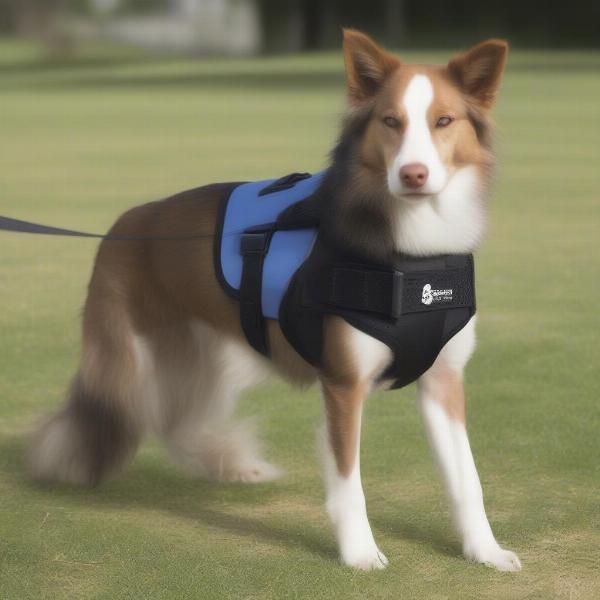A dog splint back leg can be a necessary tool for managing injuries and promoting healing. Whether your dog has suffered a sprain, strain, or fracture, understanding how to properly use a splint is crucial for their recovery. This comprehensive guide will cover everything you need to know about dog splints for back legs, from choosing the right type to ensuring proper care during the healing process.
Understanding the Need for a Dog Splint Back Leg
There are various reasons why your veterinarian might recommend a dog splint back leg. These can include:
- Fractures: Stabilizing broken bones to prevent further damage.
- Sprains and Strains: Supporting injured ligaments and tendons to reduce pain and inflammation.
- Post-Surgery: Protecting the surgical site and promoting proper healing.
- Arthritis: Providing support and stability to alleviate pain and improve mobility in older dogs.
- Neurological Issues: Helping dogs with weakened or paralyzed back legs regain some function.
Choosing the Right Dog Splint Back Leg
Choosing the right splint for your dog is crucial for effective treatment. Splints come in various materials and designs, each suited for different types of injuries. Consult with your veterinarian for the best recommendation based on your dog’s specific needs. Some common types include:
- Rigid Splints: Offer maximum support for fractures and severe injuries.
- Soft Splints: Provide comfortable support for sprains and strains, often used after surgery.
- Custom-Made Splints: Designed to fit your dog’s leg perfectly, providing optimal support and comfort.
Applying a Dog Splint Back Leg
Applying a splint requires careful attention to detail to ensure proper fit and avoid further injury. Always follow your veterinarian’s instructions closely. General guidelines for application include:
- Proper Padding: Ensure adequate padding between the splint and the leg to prevent pressure sores and discomfort.
- Secure Fit: The splint should be snug but not too tight, allowing for proper circulation.
- Regular Monitoring: Check the splint regularly for any signs of rubbing, swelling, or discomfort.
Caring for Your Dog with a Back Leg Splint
 Dog wearing a back leg splint
Dog wearing a back leg splint
Caring for your dog during the healing process is essential for a successful recovery. Here are some tips to keep your dog comfortable and safe:
- Restricted Activity: Limit exercise and movement to prevent further injury. dog leg wrap may also be used in conjunction with the splint.
- Keep the Splint Clean and Dry: Avoid moisture and dirt to prevent infections.
- Regular Veterinary Check-ups: Monitor the healing progress and adjust the splint as needed.
Conclusion
A dog splint back leg is a valuable tool for treating various leg injuries. By understanding the types of splints available, proper application methods, and essential care tips, you can help your furry friend recover quickly and comfortably. Always consult your veterinarian for personalized advice and guidance. Remember, their expertise is invaluable in ensuring your dog receives the best possible care.
FAQ
- How long will my dog need to wear a splint? This depends on the severity of the injury and your dog’s individual healing process. Your veterinarian will determine the appropriate duration.
- Can my dog walk with a splint? Limited movement may be allowed, but strict rest is often recommended, especially in the initial stages of healing.
- What are the signs of a splint complication? Swelling, redness, unusual odor, or excessive licking around the splint area should be reported to your veterinarian immediately.
- How can I keep my dog from chewing on the splint? An Elizabethan collar (e-collar) can prevent your dog from reaching the splint.
- Are there alternative treatments to splinting? Your veterinarian may recommend other treatments, such as surgery, medication, or physical therapy, depending on the specific injury.
- Where can I buy a dog splint? Your veterinarian can provide you with the appropriate splint or recommend reputable suppliers. You can also look into a rosewood dog crate for comfortable confinement during recovery.
- What should I feed my dog while they are recovering from a leg injury? Consult with your veterinarian about the appropriate diet for your dog. Consider bulk dog bone supplements for bone health.
Related Articles on ILM Dog
About ILM Dog: ILM Dog is your trusted resource for expert dog care advice. We offer a wealth of information on dog breeds, health, training, nutrition, grooming, and more. Our mission is to empower dog owners worldwide with the knowledge and resources they need to provide the best possible care for their canine companions. From understanding the best dog splint back leg options to providing expert advice on training and nutrition, ILM Dog is committed to supporting the well-being of dogs everywhere. Contact us for personalized advice: Email: [email protected], Phone: +44 20-3965-8624.